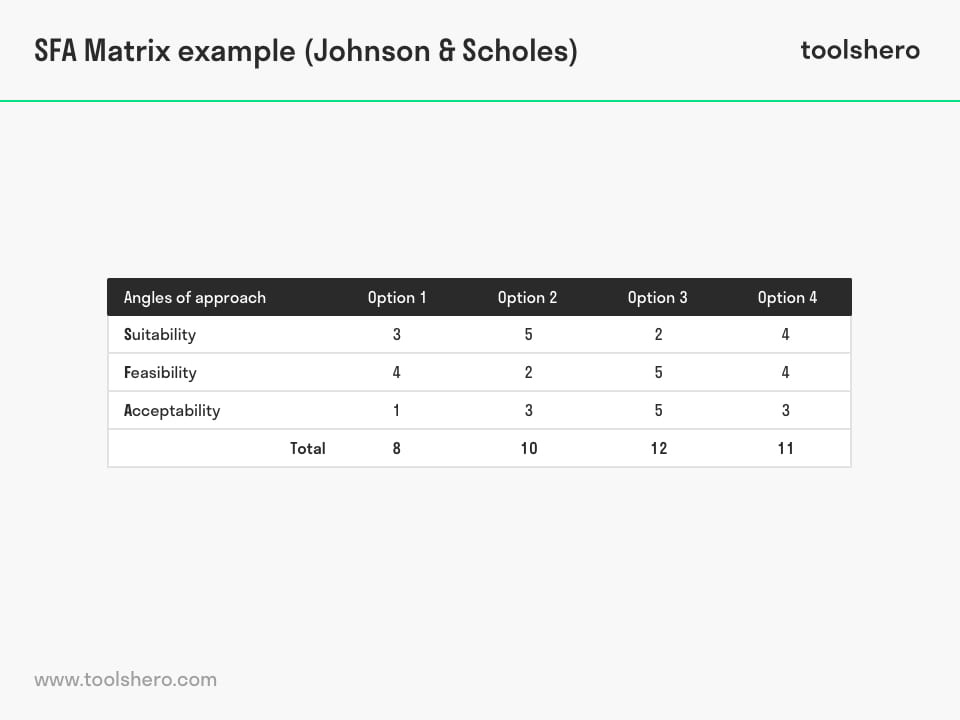SFA Matrix explained: Marketing Theory and Template

SFA Matrix: this article explains the SFA Matrix, developed by Gerry Johnson and Kevan Scholes in a practical way. Next to what it is, this article also highlights the different angles, how should the matrix be completed, a short conclusion witgh tips and a downloadable and editable SFA Matrix template. After reading it, you will understand the basics of this Strategic Marketing method. Enjoy reading!
What is the SFA Matrix?
The SFA matrix was developed by Gerry Johnson and Kevan Scholes and is a tool to analyse strategic possibilities. The acronym SFA stands for:
- Suitability: this is the extent to which the strategic opportunity is suitable for the company.
- Feasibility: this is the extent to which the strategic option is feasible. This involves looking at strengths and weaknesses that arise from an internal analysis.
- Acceptability: the acceptability of a strategic choice arises by examining at two criteria: financial aspects and the extent to which the choice fits in with stakeholders.
Making strategic choices is often difficult because the choices can have far-reaching consequences for a person or company.
By using an auxiliary tool such as this SFA model, the choice is based on the three criteria described above. Within this assessment framework, a number of questions are then asked that describe the relevant criterion.
SFA Matrix gives different angles
The strategic option is examined from different angles:
Suitability
Within the perspective of suitability, it is checked whether the option being considered is suitable for the goal that must be achieved.
For example, in practice this may mean that an analysis is carried out to investigate whether a particular product is suitable for the market in which the company operates.
When the organisation enters a new market, or has intentions to do so, the use of the SFA matrix is ideally suited to determine whether the strategic choice can be substantiated. Questions that can be asked within this criteria are:
- Are opportunities and strengths taken advantage of?
- Have the threats and weaknesses been mapped and considered?
- What desired effect does the option have?
Determining weaknesses or threats is also part of the analysis of the option. In case an organisation will expand to new markets, a DESTEP Analysis can be made after which it can be determined whether the environmental factors are suitable for expansion. The results of this analysis can be processed in the SWOT Analysis.
Feasibility
Within the perspective of feasibility, it is checked whether the option considered is in line with the opportunities that the organisation has at its disposal.
If the option is not feasible, either for practical or other reasons, it has no added value to further analyse the option. Here it is checked whether the option will be successful or not. The feasibility of an option is determined after the results from the external analysis have been processed.
A number of factors that determine the feasibility of a strategic option are:
- Can the option be financed?
- Does the organisation have the required level?
- What does the organisation’s competition do?
- Are the expectations realistic?
- Are the right resources present?
- Is the right knowledge available?
- Is the option ethical?
- Are there no legal barriers?
Acceptability
When looking at the strategic option from the perspective of acceptability, many external factors are taken into account. When tapping into a new market, a coffee exporter from Colombia can, for example, analyse how much the expected profit is (forecast ROI), which risks the expansion entails and whether all stakeholders agree with the new step.
Often the shareholders, who are also among the stakeholders, are those who ensure that the organisation is provided with capital. It is therefore also very important that they remain supportive of the organisation.
Some aspects that need to be assessed include:
- The profitability of the option
- Financial risks
- Influences from the environment (stakeholders)
How should the SFA matrix be completed?
Since some factors will weigh more heavily in deciding whether the strategic option is suitable for an organisation, it is important that the matrix is carefully prepared.
Different questions are asked for each approach angle, to which different maximum values are linked. A rating is then assigned per question. The average scores of the criteria are then compared to each other. The higher the score, the higher the chances.
The weighting and valuation of a question can be determined in different ways. Different priorities apply for each organisation and some criteria will weigh more heavily.
To determine this, analyses are needed to justify the choice. It is also a good idea to take the opinion of experts into account during difficult decisions. Determining weights in this way is qualitative.
The weightings can also be quantified. This often happens with quantifiable information such as results from financial analyses.
Conclusion
By carefully analysing strategic options, the chance of success compared to other options is determined. By looking at the options from different perspectives, a complete pattern is formed about the possible outcomes and risks of the possibilities.
A score can then be assigned to the three main criteria by means of a testing framework. The SFA Matrix is therefore an effective, comprehensive and accurate method to justify strategic choices.
SFA Matrix template
Are you ready to visualise and analyse strategic possibilities and make the best strategic choices? Get started with this SFA Matrix template.
Download the SFA Matrix template
This template is exclusively for our paying Toolshero members. Click here to see if a membership is something for you!It’s Your Turn
What do you think? Do you use the SFA Matrix to justify the strategic choices you make? Do you have any additions to the above? What do you think are the benefits of the SFA Matrix?
Share your experience and knowledge in the comments box below.
More information
- Johnson, G., & Scholes, K. (1993). Exploring corporate strategy. New York: Prentice Hall.
- Thompson, A. A., & Strickland, A. J. (2001). Strategic management: Concepts and cases. Boston, Mass: McGraw-Hill/Irvin
- Johnson, G., Whittington, R., Scholes, K., Angwin, D. and Regner, P. (2010). Exploring Strategy. 10th ed. Pearson.
How to cite this article:
Janse, B. (2018). SFA Matrix explained: Marketing Theory and Template. Retrieved [insert date] from toolshero: https://www.toolshero.com/marketing/sfa-matrix/
Published on: 06/25/2018 | Last update: 02/16/2023
Add a link to this page on your website:
<a href=”https://www.toolshero.com/marketing/sfa-matrix/”>toolshero: SFA Matrix explained: Marketing Theory and Template</a>







